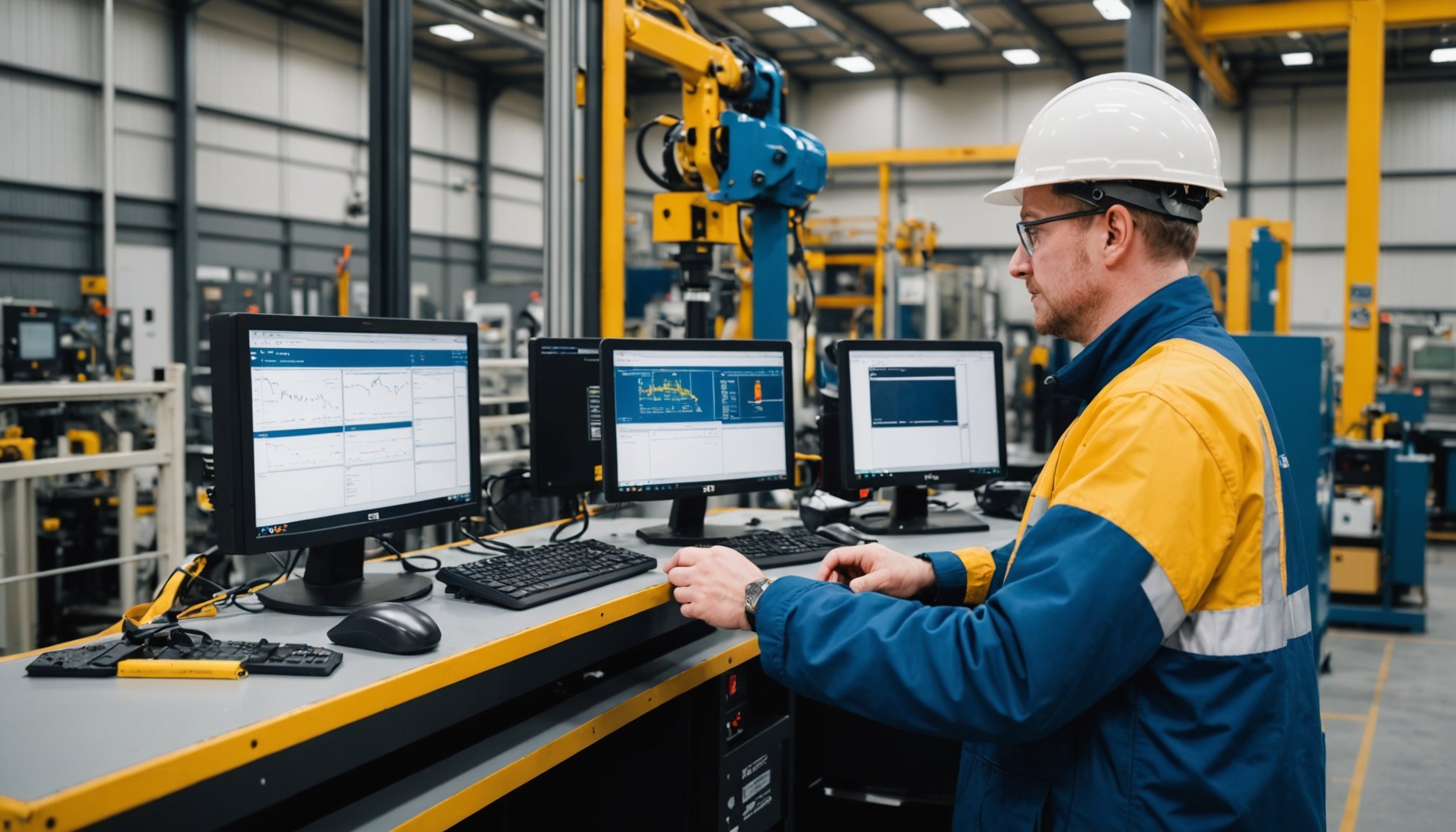Unlocking the Benefits of Remote Monitoring in UK Manufacturing: Paving the Way for Industrial Excellence
In the rapidly evolving landscape of UK manufacturing, embracing innovative technologies is crucial for staying ahead of the competition. One such technology that is revolutionizing the industry is remote monitoring. This article delves into the benefits, applications, and future implications of remote monitoring in UK manufacturing, highlighting how it can pave the way for industrial excellence.
The Basics of Remote Monitoring
Remote monitoring involves the use of advanced technologies, such as the Internet of Things (IoT), to monitor and manage industrial processes from a distance. This can include everything from machinery performance and energy usage to supply chain logistics and employee safety.
Have you seen this : Mastering digital marketing strategies: a comprehensive guide for uk small and medium businesses
How IoT Enables Remote Monitoring
IoT devices play a pivotal role in remote monitoring by providing real-time data from various sensors and machines. These devices can be connected to the cloud, allowing for continuous data flow and analysis. For instance, in the context of ocean energy, solutions like Krucial CONNECT ensure dependable insights by automatically switching between satellite and cellular networks, making them ideal for remote and harsh environments[4].
Benefits of Remote Monitoring in Manufacturing
The integration of remote monitoring in manufacturing offers a myriad of benefits that can significantly enhance business operations.
Also to see : Mastering b2b content marketing in the uk: your ultimate guide to creating a successful strategy
Improved Efficiency and Productivity
Remote monitoring allows businesses to optimize their processes in real-time. By continuously monitoring machinery and equipment, manufacturers can identify and resolve issues promptly, reducing downtime and increasing overall productivity.
- Real-time monitoring of machine performance
- Quick identification and resolution of issues
- Reduced downtime
- Increased productivity
- Optimized maintenance schedules
For example, in the digital experience monitoring (DEM) context, real-time visibility into the performance and availability of digital services helps organizations identify issues quickly and take corrective action, ensuring that the end-user experience is always optimized[1].
Enhanced Decision Making
With the wealth of data provided by remote monitoring, businesses can make more informed decisions. This data can be analyzed to identify trends, predict potential issues, and optimize processes.
- Data-driven decision making
- Predictive maintenance
- Trend analysis
- Process optimization
- Improved resource allocation
Esther Rodriguez Villegas, founder of Acurable, emphasizes the importance of data in remote monitoring: “Devices that are successful will combine the precision of conventional clinical-based equipment and/or healthcare professionals themselves with the convenience and ease of use of a smartphone. Over time, they have the potential to become ‘thermometers’ of conditions: a device that everyone has at home to diagnose, monitor or manage a variety of health problems”[3].
Cost Savings and Reduced Operational Costs
Remote monitoring can significantly reduce operational costs by minimizing the need for physical inspections and reducing the risk of equipment failure.
- Reduced need for physical inspections
- Lower maintenance costs
- Reduced risk of equipment failure
- Energy efficiency
- Lower operational costs
In the context of ocean energy, remote monitoring solutions like Krucial CONNECT help maximize the efficiency of ocean energy systems, ensuring stable and reliable energy output. This not only reduces costs but also enhances the overall performance of the systems[4].
Competitive Advantage
In a highly competitive industry, adopting cutting-edge technologies like remote monitoring can provide a significant competitive advantage. Businesses that leverage remote monitoring can offer better services, improve customer satisfaction, and enhance their brand reputation.
- Enhanced customer satisfaction
- Improved brand reputation
- Competitive advantage
- Better service delivery
- Increased customer loyalty
For e-commerce businesses, DEM is crucial for providing a seamless and reliable digital experience, which is critical for success. It helps in identifying and resolving issues that impact user experience, thereby increasing sales and enhancing brand reputation[1].
Case Study: Remote Monitoring in Mining
To illustrate the practical application of remote monitoring, let’s consider a case study from the mining industry.
Remote Monitoring of CP Systems
In mining, remote monitoring of cathodic protection (CP) systems is essential for ensuring the integrity of infrastructure. This involves 24/7 monitoring of energy usage and enhanced data auditing abilities.
| Aspect | Traditional Method | Remote Monitoring |
|---|---|---|
| Data Collection | Manual, periodic inspections | Real-time data collection via IoT devices |
| Issue Identification | Issues identified during scheduled inspections | Issues identified in real-time, allowing for immediate action |
| Maintenance | Scheduled maintenance based on historical data | Predictive maintenance based on real-time data |
| Cost | Higher costs due to manual inspections and potential equipment failure | Lower costs due to reduced need for physical inspections and predictive maintenance |
| Efficiency | Lower efficiency due to downtime and delayed issue resolution | Higher efficiency due to real-time monitoring and quick issue resolution |
Remote monitoring of CP systems in mining not only enhances efficiency but also ensures the safety of the infrastructure and reduces operational costs[5].
The Role of Artificial Intelligence in Remote Monitoring
Artificial intelligence (AI) is increasingly being integrated into remote monitoring systems to enhance their capabilities.
AI-Driven Insights
AI can analyze the vast amounts of data generated by IoT devices to provide deeper insights and predictive analytics. This can help in identifying potential issues before they occur and optimizing processes for better efficiency.
- Predictive analytics
- Real-time insights
- Automated decision making
- Enhanced process optimization
- Improved asset management
In the security monitoring sector, AI is reshaping how organizations protect their assets and infrastructure. By harnessing the power of AI, security systems can become more proactive and efficient[2].
Future of Remote Monitoring in Manufacturing
As technology continues to evolve, the future of remote monitoring in manufacturing looks promising.
Smart Cities and Smart Manufacturing
The concept of smart cities is extending into smart manufacturing, where entire production lines are managed and monitored remotely. This integration of IoT and AI technologies is set to revolutionize the manufacturing industry.
- Integrated IoT and AI technologies
- Real-time monitoring and management
- Predictive maintenance
- Enhanced efficiency and productivity
- Smart energy management
Research and Development
Continuous research and development in remote monitoring technologies are expected to bring about new innovations. For instance, the use of low-latency networks and advanced IoT devices will further enhance the capabilities of remote monitoring systems.
- Advanced IoT devices
- Low-latency networks
- New use cases and applications
- Enhanced data security
- Improved user experience
Practical Insights and Actionable Advice
For businesses looking to implement remote monitoring, here are some practical insights and actionable advice:
Start Small
Begin with a pilot project to test the feasibility and benefits of remote monitoring in your specific context.
Choose the Right Technology
Select IoT devices and monitoring solutions that are tailored to your industry and specific needs.
Train Your Team
Ensure that your team is well-trained to handle the new technology and interpret the data effectively.
Focus on Data Security
Implement robust data security measures to protect the sensitive information generated by remote monitoring systems.
Continuously Evaluate and Improve
Regularly evaluate the performance of your remote monitoring system and make improvements as necessary.
In conclusion, remote monitoring is a powerful tool that can transform the manufacturing industry by enhancing efficiency, reducing costs, and providing a competitive advantage. As we move forward into the future, the integration of AI, IoT, and other cutting-edge technologies will continue to shape the landscape of remote monitoring, paving the way for industrial excellence.
By embracing remote monitoring, UK manufacturing businesses can not only stay competitive but also drive innovation and excellence in their operations. Whether it’s through improved efficiency, enhanced decision making, or cost savings, the benefits of remote monitoring are clear. As the industry continues to evolve, one thing is certain: remote monitoring will play a pivotal role in shaping the future of manufacturing.











